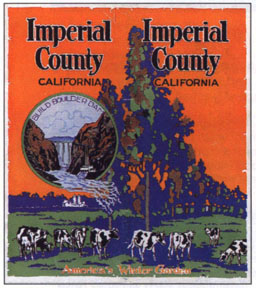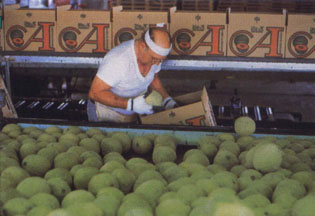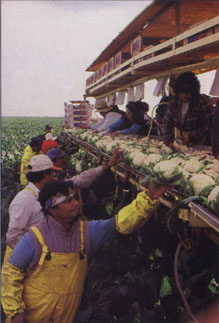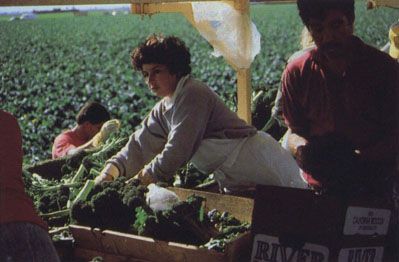All Issues
Challenge, promise for nation's “winter salad bowl”
Publication Information
California Agriculture 51(3):4-6.
Published May 01, 1997
PDF | Citation | Permissions
Full text
In 1902, when the immigrant great-grandparents of Don Barioni, Jr. settled in the Imperial Valley to raise dairy cattle, there were a couple of tents on Main Street and for air conditioning the early pioneers wrapped their bodies in wet sheets and hoped for a breeze.
Today in the nation's “winter salad bowl,” agriculture is nearly a billion-dollar industry that to a large degree sustains a population of 141,500 in this remote desert county in southeastern California. And fourth-generation farmer Barioni is typical of the modern-day desert grower — progressive, diversified and flexible — who has helped raise the profile of desert agriculture in the nation's leading farm state.
Farming on a total of 3,000 acres in two separate locations, Barioni grows citrus and jojoba in addition to alfalfa, a traditional crop of the region. He recently registered jojoba oil as a “soft” pesticide — one that inhibits the feeding of insects, such as the voracious silverleaf whitefly, while minimizing environmental damage. And his farms operate the valley's first and largest drip- and sprinkler-irrigation systems — technologies that diminish runoff and reduce the amount of salt-laden water that drains into the Salton Sea.
Along with such innovative crops, desert growers in the Imperial Valley and surrounding areas provide 80% of the nation's fresh winter fruits and vegetables. As impressive as this is, many here believe that desert agriculture is poised for economic expansion — especially as domestic and international markets for food and fiber grow and prime farmland in other parts of the state is plowed under for development.
Others see challenges ahead, ranging from pest invasions to water politics. For instance — although growers enjoy relatively cheap and abundant water supplies from the Colorado River — there is increasing pressure on them to conserve water in light of Southern California's need to live within its original Colorado River water allotment. (The state has grown accustomed to taking about 20% more; see page 6 .) In addition, the river water is high in salts, which reduce productivity. When farmers use additional water to flush the soil, salt-laden waste-water flows through a tile system to the Salton Sea, contributing to environmental problems ( see page 8 ).
1927 Imperial County brochure. Agriculture's roots run deep in Imperial Valley history. Courtesy of Imperial County Cooperative Extension.
Despite the challenges, many factors favor the ascendance of desert agriculture — now a 675,000-acre enterprise in the Imperial, Palo Verde and Coachella valleys. The climate affords a year-round growing season, water is reasonably priced and the soil is enriched by alluvial deposits from the Colorado River flood plain. These are up to a mile deep in some places, according to the American Farmland Trust.
“Growers here are sophisticated and diversified. They have large and flexible crop portfolios,” says Refugio “Cuco” Gonzalez, director of the Imperial County office of UC Cooperative Extension. In addition, a number are vertically integrated, meaning they grow the crop, pack it, ship it and even market it, he said.
The Imperial, Coachella and Palo Verde valleys — and to a lesser degree the Mojave River basin of San Bernardino County and the inter-mountain areas of Inyo and Mono counties — sustain a surprising variety of agricultural products. Specialty crops like artichokes and bokchoy join such traditional staples as alfalfa grown for livestock forage and sudangrass (exported as forage to the Pacific Rim) to form a complex, year-round cropping system. This diversity helps give the desert regions a competitive advantage, according to Gonzalez.
External factors could also make this an opportune time for desert growers to flourish, among them the North American Free Trade Agreement (NAFTA). The Imperial Valley is expected to see increased trade traffic in both directions, as well as more strategic alliances between growers in both the United States and Mexico to produce fruits and vegetables, Gonzalez says. While the ultimate impact is uncertain, he says it may encourage “value-added” industries — such as millers, creameries, trucking firms and warehouses — to relocate in the valley.
Urbanization of prime farmland elsewhere in the state may also become an important factor in the evolution of desert agriculture. The state's population is expected to double by the year 2040. If urban developments replace farmland, California could lose 17% of the present agricultural base (see California Agriculture Nov.-Dec. 1995). The state Department of Conservation's Farmland Monitoring and Mapping Program has found significant farmland acreage losses in a number of counties, including Riverside County, where farmland decreased from nearly 703,000 acres in 1984 to 648,000 in 1994.
The fertile San Joaquin Valley, too, is urbanizing rapidly, with Fresno County losing more than 32,000 acres between 1984 and 1994 and Kern County losing an estimated 60,000 acres during the same period. While the loss of farmland to urbanization in other areas of the state has not yet caused a commensurate boom in the desert, economic opportunities are expected to rise.
While making the most of new opportunities, growers must continue to address the problems inherent in year-round production systems. And their historic partnership with UC scientists is helping them to do so.
Perhaps the most serious challenge to the desert regions' productivity is repeated pest invasions. A climate that allows year-round growing has, over the last 40 years, led to “problems of pestilence that read like the days of the Old Testament,” according to Claude Finnell, who served as agricultural commissioner of Imperial County for more than three decades. With plants always in the ground, bugs are able to feast constantly on a virtual salad bar of crops that includes lettuce, alfalfa, peppers and citrus.
The most recent examples are the silverleaf whitefly, which caused $336 million in crop damage between fall 1991 and April 1994 in Imperial Valley ( see page 25 ), and the wheat-blighting Karnal bunt fungus, which prompted a federal quarantine in 1996 and caused revenue losses of nearly $58 million in the Imperial and Palo Verde valleys ( see page 29 ).
There also is greater awareness by local growers of the need for water conservation, especially in light of efforts to divert some of the desert region's Colorado River water allotment to urban uses, according to John Grizzle. Grizzle, who began farming in the Imperial Valley in 1964, now cultivates some 6,000 acres with alfalfa, wheat, sudangrass and, in the winter, lettuce, broccoli and cauliflower.
Colorado River water is fed by gravity to the Imperial Valley via the All American Canal and delivered to fields through an extensive infrastructure of canals. Excess water drains into the Salton Sea. Irrigation also subjects the desert soil to the buildup of salts and trace elements that threaten the productivity of the land and the environment ( see page 34 ). To reduce the impact of salinity, growers typically apply more water than the crop requires with the excess used to leach salts out of the soil and into a subterranean system of porous tile drains that captures some of the salts.
“If agriculture is going to remain, we have to come up with ways to conserve water or grow crops with less water,” said Robert Kallenbach, Cooperative Extension vegetable and field crops advisor for the Palo Verde Valley. “A lot of research needs to be directed that way.”
From top to bottom: Melons, cauliflower and broccoli are among the many crops grown in the Imperial and Palo Verde valleys during their mild winters.
Drip- and sprinker-irrigation systems that reduce runoff are not necessarily the ultimate answer for conserving water, according to Grizzle, because of evaporation. And there are currently 19 experimental fields in the Imperial Valley — one on Grizzle's farm — to study return systems, where drainage water is recaptured and mixed with fresh water for re-irrigation.
The University of California has played, and will continue to play, a critical role in conducting research to address these problems and to develop new crops for the desert, including nontraditional crops and those that are heat-tolerant and require less water.
Research leading to new farming opportunities also shows promise for further diversifying desert agriculture, Gonzalez says. With development pressures in the Chino area of Riverside County and a ready supply of alfalfa hay in the Imperial Valley, there is an effort to attract more dairies to the Imperial Valley. UC research has found that dairying in the region may be economically feasible in spite of the high cost of cow-cooling technologies ( see page 17 ).
UC and U.S. Department of Agriculture scientists have also been studying kenaf, a nontraditional crop that can be used to manufacture paper. If paper mills can be attracted to the region, kenaf may also become an economically attractive crop.
The advent of new crops, scientific advances to increase yield in traditional desert crops, a year-round growing season and ready water supply hold promise for the future of desert agriculture, Grizzle says. “I think (prospects) are tremendously bright for agriculture here in the Imperial Valley,” he says. “The Imperial Valley is very unique. We can grow anything in the right season.”








